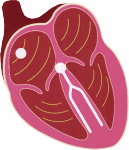How the Heart Works:
The heart is essentially a pump that involves two parallel circuits. The first circuit involves blood from the body being delivered to the right side of the heart, then being pumped to the lungs to pick up oxygen. Blood then returns to the left side of the heart for the second circuit. It is then pumped to the rest of the body to deliver the oxygen to needy tissues and body organs.

In order for heart muscle to act as a pump, it needs be electrically activated in a systematic manner.
First, the heart beat is initiated by the body’s own pacemaker (sinoatial node). This is located in the right atrium and sparks a wave of electricity to pass across the chamber. The right atrium then contracts in a uniform manner pushing blood across the tricuspid valve into the right ventricle. At the same time, the electrical wave from the atrium then converges on the conducting system that would then activate the right ventricle.
Because electricity flows quicker than blood, there is an intrinsic delay set in the atrioventricular node to allow time for the blood to accumulate in the right ventricle before it is pumped out to the lungs. So, after the right ventricle has filled, it is then electrically activated to pump the blood across the pulmonary valve to the lungs.
In the left heart the same effects are occurring at approximately the same time. The electrical wave that was passing across the right atrium also passes across the left atrium. This allows blood returning from the lungs to be propelled across the mitral valve into the left ventricle. When the left ventricle has filled, the electrical wave that is activating the right ventricle will almost simultaneously be activating the left ventricle. Blood is then pumped across the aortic valve to the rest of the body.
|